As related in the previous post on Capitol Hill’s alleys, their inherently less public nature creates a social environment distinct from that of their associated streetscapes. Furthermore, this distinct environment has fostered experimentation in the design of alley landscapes and buildings. While not in the avant-garde, these experiments can nonetheless be seen as a foil to the more ordered and regular streetscapes they are paired with. Some alley experiments are simply whimsical and relatively ephemeral in nature, others relatively daring in their re-conceiving of typical alley elements into bolder more modern constructs, exploiting the alley as a vehicle for design exploration.
One impetus for alley experiments is found in the blending & compacting of roadway, sidewalk, and landscape into an area of less girth than our streets, and, therefore, to lesser expectations for openness and transparency. An indicator of this variance with the normative can be seen in the retaining walls that frequently demise the alley, but at a scale and opacity rarely seen on streets. Such robustness results from the fact that alleys and their walls are frequently used to terrace grades along our hilly landscape. Charged with retaining massive amounts of earth, alley walls cannot be bothered with the niceties of pedestrian scale and detail that are incumbent street side, and are therefore able to more efficiently discharge their duty. Pictured below is a landscape wall that directly and unapologetically dispenses with its retaining chores, and is a good representative of the normative condition.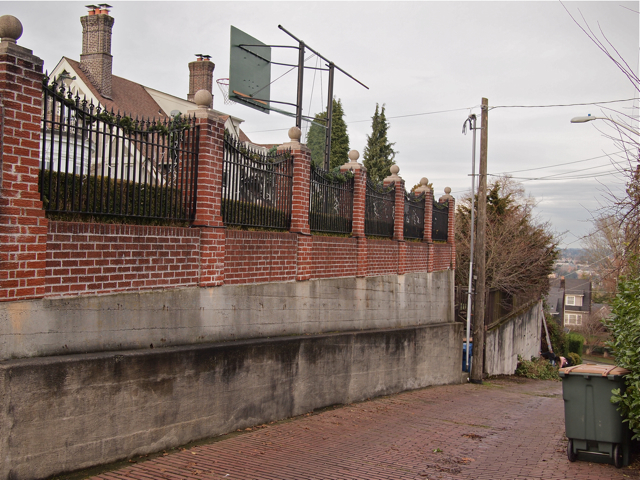
On Capitol Hill’s alleys such large retaining walls often contain other service elements, including garages. Combining programmatic elements is perhaps only mildly experimental, and is much like the wall-garage combinations in Capitol Hill’s Harvard historic district. The wall-garage combo pictured below deftly combines it various services, and to the extent possible, is traditionally detailed and landscaped. And though thoughtfully executed and within the stylist expectations of the neighborhood, such a length of predominantly blank wall would cause an outcry if it were on the street and would be seen as an affront to neighborliness. On the alley, however, such a carefully designed wall/garage/landscape can actually be seen to be in the best of taste.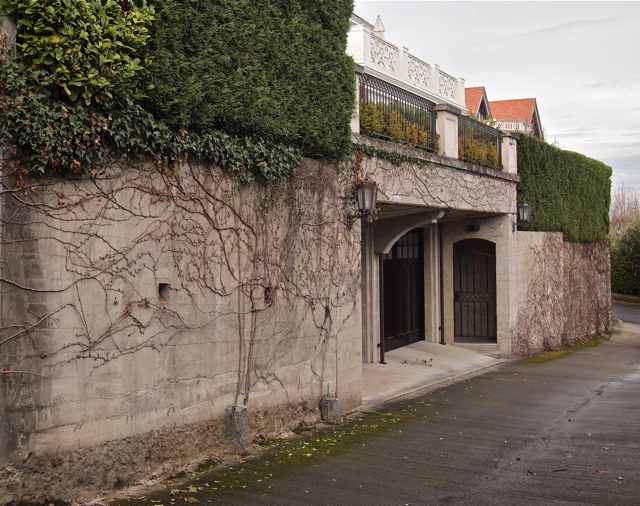
Just up the alley from the above example (next door to it, in fact) is a decidedly modernist interpretation of the same typology. And most likely for the same traditional type of home that the above serves. Bold in its geometry and Spartan in detail, its design is most certainly not derivative of the home is serves, and provides a contemporary counterpoint to what is typically seen on the street in this section of Capitol Hill. The only relief to the mass of the wall is the setting back of the three garage doors and one pedestrian door, both similar to the previous example, but again, lacking the architectural embellishments.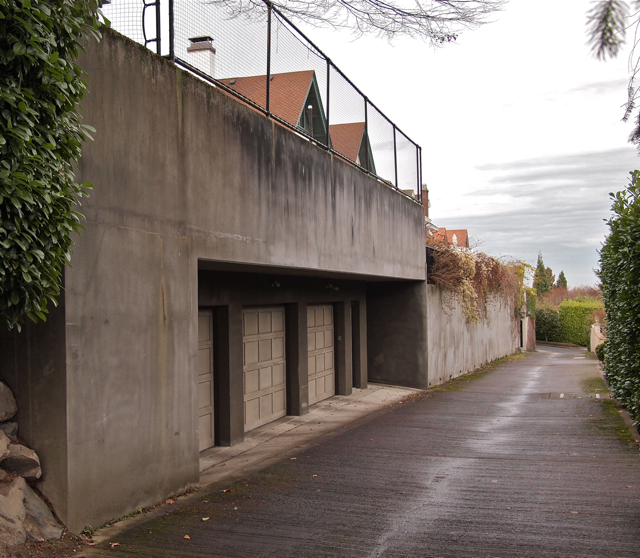
Not all alley experiments are so willful. While it is hard to miss the above two examples, alley experiments appear in smaller, subtler ways, with the glass block wall below a fine example. Glass block and good design are not typically uttered in one sentence, glass block perhaps the most abused of modernist tropes; yet, pictured below is an attractive use of this beleaguered material as one is to find on the Hill. Here, the adjacent bamboo blends in perfectly with the wall; its distinctive, modernist lines adeptly blending with the lines of the glass block.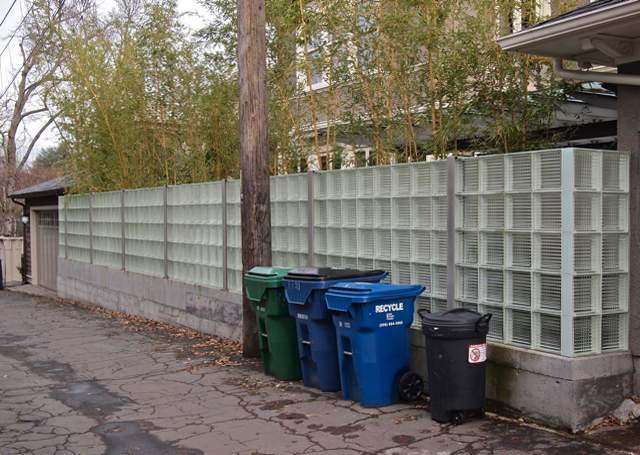
Fortunately, such modernist expressions are not restricted to the landscape. Entire modernist buildings are realized in our alleys, allowing for the fulfillment of the latent modernist design leanings of homeowners — leaning that they are otherwise too timid to express street side where they would be in full view of watchful neighbors whose design prerogatives most likely lean toward maintaining the decorum of the otherwise traditional homes and landscapes. Alleys, on the other hand, are the perfect crucible for those having the vision — but not necessarily the brashness — to pepper a bit of contemporary in our neighborhood.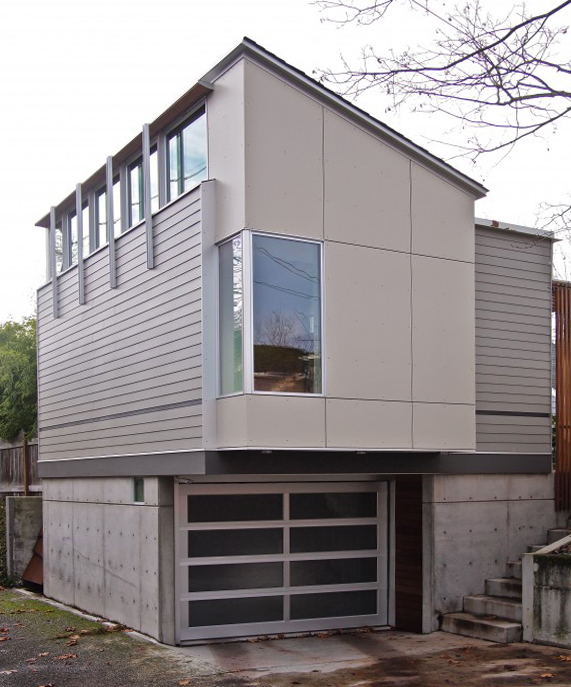
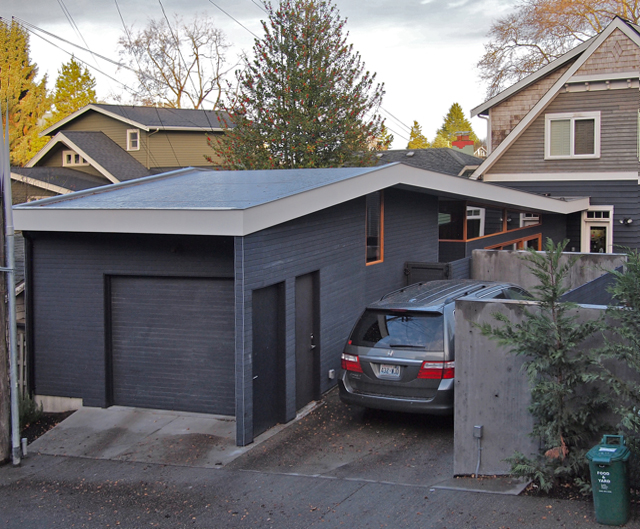 And it not simply modernist deviants that are to be found in our alleys. There are hyper-craftsman buildings as well, where the vocabulary of the quintessential Seattle home is taken almost to extremes, and certainly closer to its proximate oriental influences. Not that such a finely crafted garage as picture below would be out of place on the street, but the fact that it is an alley dweller makes its discovery ever more delightful. That such care and craft would be expended on a ‘mere’ utilitarian object, bespeaks the importance of utility in our lives.
And it not simply modernist deviants that are to be found in our alleys. There are hyper-craftsman buildings as well, where the vocabulary of the quintessential Seattle home is taken almost to extremes, and certainly closer to its proximate oriental influences. Not that such a finely crafted garage as picture below would be out of place on the street, but the fact that it is an alley dweller makes its discovery ever more delightful. That such care and craft would be expended on a ‘mere’ utilitarian object, bespeaks the importance of utility in our lives.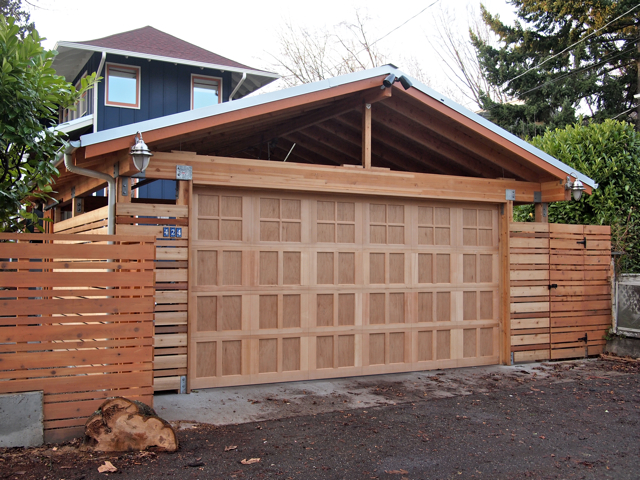
The most singular design example of alley experimentation I came across in this small section of Capitol Hill was perhaps one that expressed none of the previous mentioned dualities; in fact, it was an example of a home whose landscape and architectural expression on the alley make it indistinguishable from that on the street. Admittedly, it does take some means to maintain decorum on both street and alley frontages, but it also takes a bit of s contrarian stand, in that this homeowner does not feel the need to distinguished between servant and served . Those of similar means have chosen a different route, as witnessed by the to imposing garages at the beginning of this post, which are across from the one below.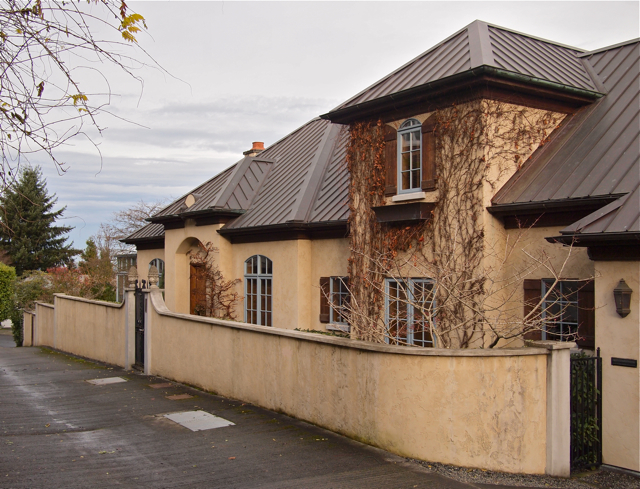
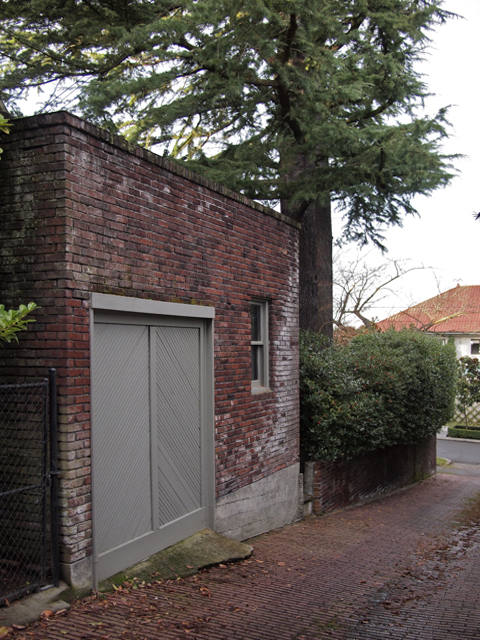 Despite of, or perhaps because of, Capitol Hill’s heterogeneous alley landscape the above building and landscape I found to be the most compelling. The simplicity of its form and the honest expression of its utility are captivating, its patinaed brick cladding matching that of the alley and the low landscape wall. While not experimental itself, it forms the quintessential alley building/landscape prototype against which to measure those homeowners who are more experimentally inclined, making the above artist forays resonant, and grounding them within a larger cultural context.
Despite of, or perhaps because of, Capitol Hill’s heterogeneous alley landscape the above building and landscape I found to be the most compelling. The simplicity of its form and the honest expression of its utility are captivating, its patinaed brick cladding matching that of the alley and the low landscape wall. While not experimental itself, it forms the quintessential alley building/landscape prototype against which to measure those homeowners who are more experimentally inclined, making the above artist forays resonant, and grounding them within a larger cultural context.
Recent CHS Schemata Posts:
- Capitol Hill’s alley landscapes
- 106 steps of civic design greatness at the top of Capitol Hill
- A California transplant, in Pacific Northwest style, on Capitol Hill
John Feit is an architect on Capitol Hill, and works at Schemata Workshop. He blogs frequently on design and urbanism, with a focus on how they relate to and affect the Capitol Hill community.



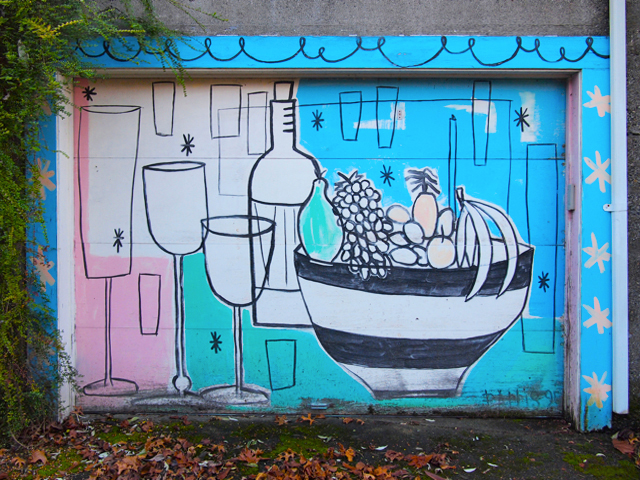

While the poster seems deeply aware of current trends in architectural theory, the de-contextualized framing is of questionable appropriateness for a blog that covers neighborhood events in a style which assume that the implicit cultural milieu of capitol hill is an inherent feature of the early 22nd century. The stylistic discontinuity introduced by criticism immersed in a language with which the audience is unfamiliar forces the audience to engage deeply with the next post.
In other words, please either find language that’s appropriate for the venue, or a venue appropriate for the language.
Au contraire! No reason a knowledgeable blogger in a field should reduce to a “Basic English” world of concepts. Just look at the cool pictures if you wish.
For me, part of the fun of perusing the CHS blog is precisely the site’s discontinuity and variety. Sure, skip over posts of no or little interest. But there are gems to be found for everyone’s individual tastes. For me, John Feit is an enormous gem, allowing me to comprehend and appreciate Capitol Hill in a much deeper way. I even applaud his graduate-student composition style, and gladly make the effort he imposes on his readers to grapple with the lingo inherent to academic and architectural criticism. (Having said that, is his use of “demise” in “the retaining walls that frequently demise the alley,” really the correct word?) Somehow, a Sunday that starts with a Feit essay makes me a happier and more optimistic person.
This one might have been a little heavier than others but I’ve given the dissonance issue a great deal of thought and I’m happy with it. In the beginning, CHS “featured” even more greater variability in tone/language/grammar/style/quality as I was able to produce fewer news posts than I do now. As the business has grown, my reporting has grown. But my intention has never been to create a single-voice site. Recent months have only felt that way. You’ll hear from more and more people on CHS (again) as we move forward this year. So, long comment, short, expect variety, check bylines, enjoy the different voices. Or, yeah, look at the pretty pictures :)
I’m happy to look at the pictures, and I’m perfectly fine with complex language and cultural critiques. And I’m interested in what he has to say.
But I’m not so interested as to slog through the language thicket, and there might be other folks who feel the same way.
I had no idea there were such beautiful alleys in the neighbourhood. I only have experience with the one between Harvard and Broadway that my building is situated on (garage entrance), which at least in that section is very uninspired –modern buildings, the brick facade at Olive Way suddenly becomes boring, untreated, unwashed concrete all around.
I was up on the roof of my building just yesterday, thinking about the previous post on alleys, and noticed that just north of here, a couple of the buildings on Broadway actually have very nicely kept and styled alley presences. It got me thinking of how nice it would be if we further separated pedestrians from cyclists and cars and made something more like an alley the primary face of the building, leaving the cars/parking on the ugly, unmaintained boring concrete slab sides of buildings.
Capitol Hill, land of boring yet functional $1 million garages. Nice.
I represent Pittsburgh Corning Glass Block. I have been in the business for over 12 years … Never seen such an application!
Thanks for opening my eyes this this unique design.
I am not trying to write in complex language, and I apologize if I put off some readers. I write about the ordinary design one finds on the Hill, and try to elevate it beyond the everyday by describing it with an informed and critical eye. My hope is that the readers will do the same and develop their own critical skills, making the ordinary into something special for themselves, and raise the level of design dialogue for us all in our neighborhood.
Thank you for the comments.
p.s. I took some liberties with demise, it is from demising wall; or, a wall or partition that separates one space/tenant from another. I will try not to use technical jargon again.
John Feit writes about something he knows about and cares about, and takes the time to post. His pieces provide a fresh, informed look at the neighborhood, and although his writing style may not be to everyone’s taste, he does write under his real name. I appreciate that.
— Kay Rood
Your fans want a published anthology of your CHS postings, along with those great photos. They’re meant to be reread and gazed at. Hope that’s part of your plan!
Alley walks are educational and entertaining – they tell you more about the inhabitants than the front although comparing both is often reveling.
John, the photos are really intriguing. They frame something a pedestrian tends to see in motion. I wonder if the next round of alleys could be those behind apartments and/or businesses? Are they different in some ways, or much the same in being rather unique to the sites? Thanks for these.
I think that this essay works as photo essay, as well as a more complex one, that includes text. I know Capitol Hill alleys the best. Having walked quite a few, I have always found the variety of textures and form really interesting. Walking these alleys is another way of viewing the streetscape. Although perhaps it would be a good idea to cut down on “architecteese” or architectural jargon, I appreciate this essay. Please do not take the other criticisms too much to heart, and thanks for bringing this to our attention!
I heart John Feit. And Schemata Workshop. Thanks for another great post.
I’ve rented a converted garage/art studio in an alleyway between 17th & 18th for the past 14 years which lead me to discover these “roads less traveled”. It’s nice to hear someone else’s impressions…
Wonderful to see the Parris painting on that garage door. Such a lovely view you’ve taken here. That alley between 22nd and 23rd was a constant childhood playground for us in the 70s. The drainage cubbies in the wall of that house closest to Highland were a favorite nudie magazine stash location for the older kids roaming around. The Tuscan-via-Bellevue abomination across the alley was then a lovely vacant lot for us to play in, the Clover we called it. That part of the hill’s become so uniformly posh now I hardly recognize the vibe.